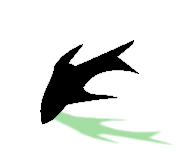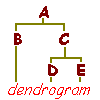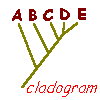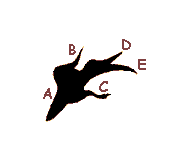
That, basically, is the question asked by a biologist applying systematics
to classify an organism. It may be a specimen taken during an ecological
sampling program and the information could contribute to an assessment
of biodiversity (clearly important in conservation terms) or it may be
an item in a taxonomic study, concerned with providing information of direct
application in the classification of more individual organisms.

We'd probably need to take a closer look, like this perhaps:
Now we can see a bit more and it would appear to be some kind of fish.
With some idea of the kind of organism under examination, we could then
look in much greater detail to see particular characters which would allow
us to identify the species to which it belongs. Quite possibly, we could
use a dichotomous key in which the presence/absence or precise form of
characters to make decisions and work through a series of such decisions
and eventually decide to which species he specimen belongs. The whole range
of possible features can provide taxonomic information. The most obvious
sort of character, of course, is structural or anatomical - "What does
it look like?" - but all kinds of features could be used, even aspects
of behaviour, habitat preference, geographical distribution, and so on.
Physiology and biochemistry can provide useful information and with modern
technology the direct sequencing of DNA can help.
This is the practical application of taxonomy - the science
of biological classification, generating names for coherent groups of organisms
and arranging these groups in relation to each other.
 Biologists
use hierarchical classification, which is best appreciated as a dendrogram
(from the Greek 'dendros' meaning branch) - a branching diagram showing
the relationships:
Biologists
use hierarchical classification, which is best appreciated as a dendrogram
(from the Greek 'dendros' meaning branch) - a branching diagram showing
the relationships:
As you can see here, group A can be divided into groups B and C, and
group B also comprises groups D and E. This is looking at the dendrogram
in a divisive fashion (splitting up the groups); alternatively, you could
work upwards through the dendrogram, lumping groups together (agglomerative
approach). Thus, in Th. latter approach we can say that D and E clump together
into group C, which together with group B forms group A.
Of course, a biological classification makes most sense when we have
some idea of the evolutionary relationships between the groups - this is
called phylogeny, the evolutionary development of groups of organisms.
A modern approach is cladistics, describing the descendency
of one group from another (that is a clade). Taxonomists look for special
characters which provide evidence for such close links (these characters
are called synapomorphic - from the Greek 'synapo-' = joining).  This
approach generates a cladogram, in which recency of common descent is the
criterion for linking groups. Care is needed, for a character to be a true
synapomorph it must have common ancestry and be essentially equivalent
in the two groups (another term for this is 'homologous'). False conclusions
can be drawn if a character is symplesiomorphic, i.e. is just a character
which has been "left over" from an earlier ancenstral group, or if it is
the result of convergent evolution, i.e. looks similar but has separate
origins (= 'analogous') in which case the two groups don't actually share
the character but just have two different characters which look similar.
A plesiomorph is a primitive character, in contrast to a apomorph which
is a derived (or advanced, modified) character. A neat
outline of cladistics has been written by Lynne M. Clos, or ther's
a good set of definitions
for cladistics by M. Tevfik Dorak (with lots of good links to other
relevant pages).
This
approach generates a cladogram, in which recency of common descent is the
criterion for linking groups. Care is needed, for a character to be a true
synapomorph it must have common ancestry and be essentially equivalent
in the two groups (another term for this is 'homologous'). False conclusions
can be drawn if a character is symplesiomorphic, i.e. is just a character
which has been "left over" from an earlier ancenstral group, or if it is
the result of convergent evolution, i.e. looks similar but has separate
origins (= 'analogous') in which case the two groups don't actually share
the character but just have two different characters which look similar.
A plesiomorph is a primitive character, in contrast to a apomorph which
is a derived (or advanced, modified) character. A neat
outline of cladistics has been written by Lynne M. Clos, or ther's
a good set of definitions
for cladistics by M. Tevfik Dorak (with lots of good links to other
relevant pages).
For a good application of cladistics to spiders see Chapter 10 of Foelix Rainer's book Biology of Spiders, 2nd. ed., published by Oxford University Press in 1996.
 An
artistically-drawn cladistics diagram may look something like this,
An
artistically-drawn cladistics diagram may look something like this,
more like a phylogeny, which is not too different from the old (mid-19th
century) family trees representing classificatory schemes.
(Not really too different either in general form from our little fish up above, which in its overall shape could be taken for a phylogenetic diagram - handy as a wee logo for this page!)
 Back to Opiliones Notes
Back to Opiliones Notes |
|

Back to Home page |